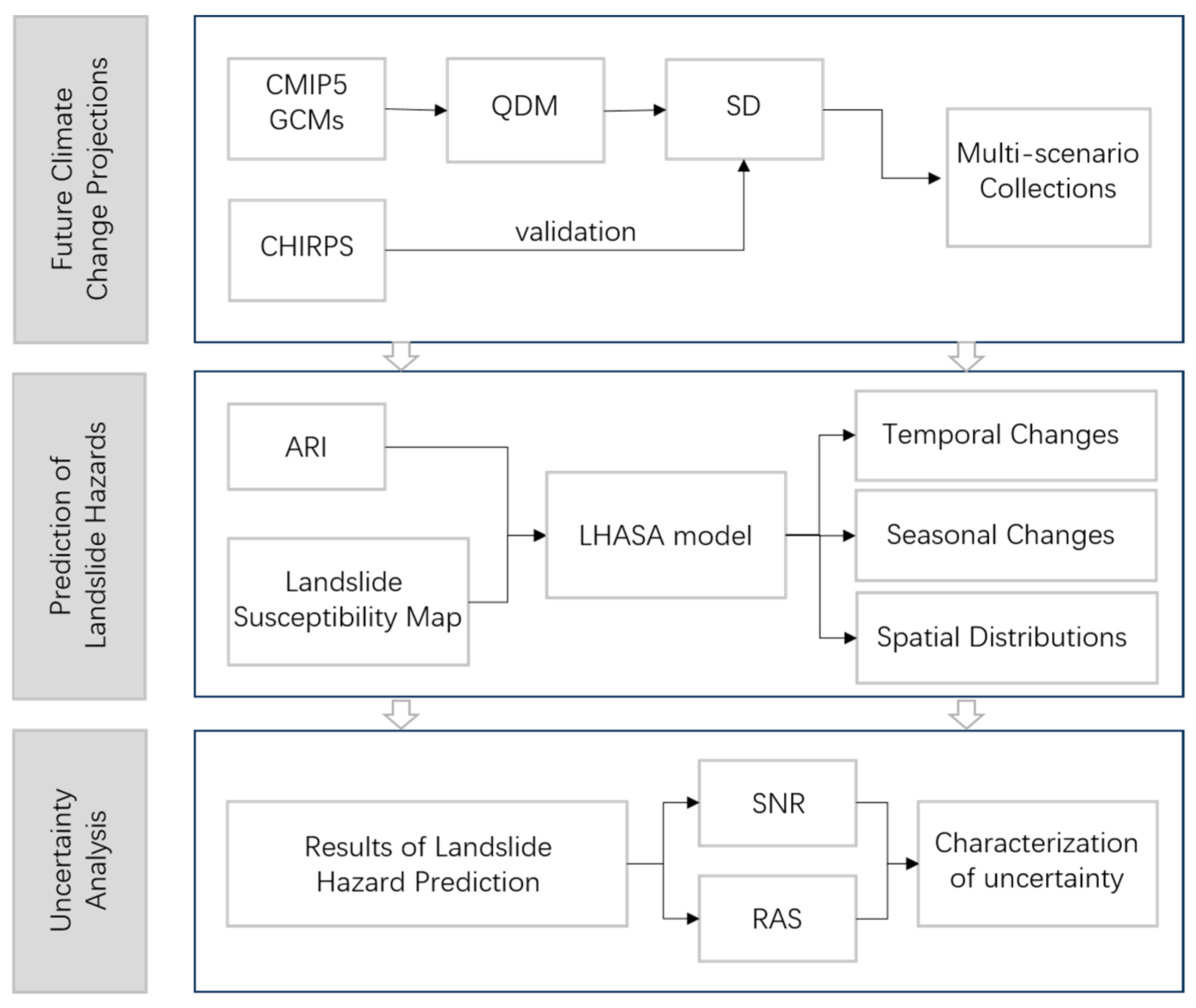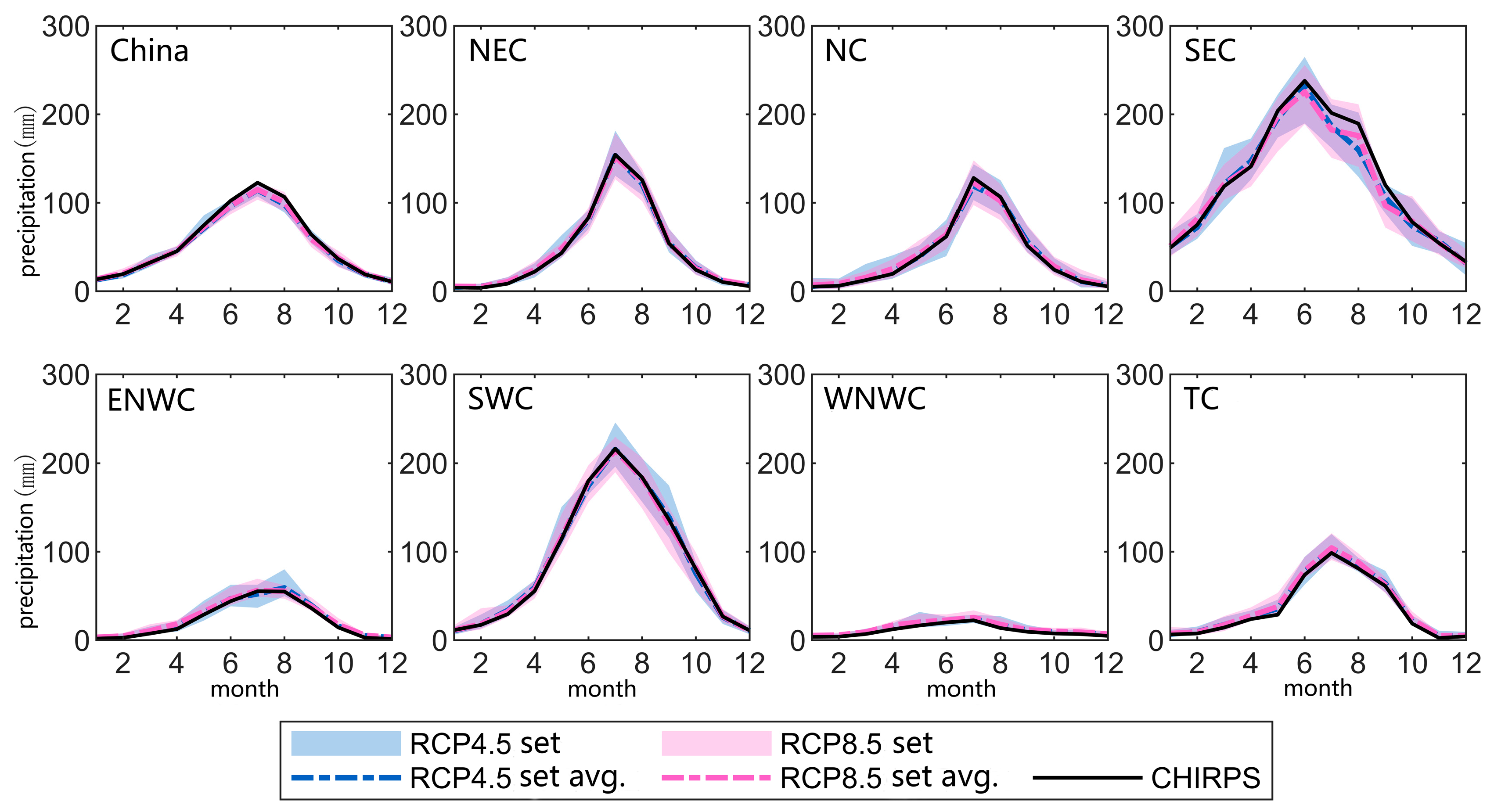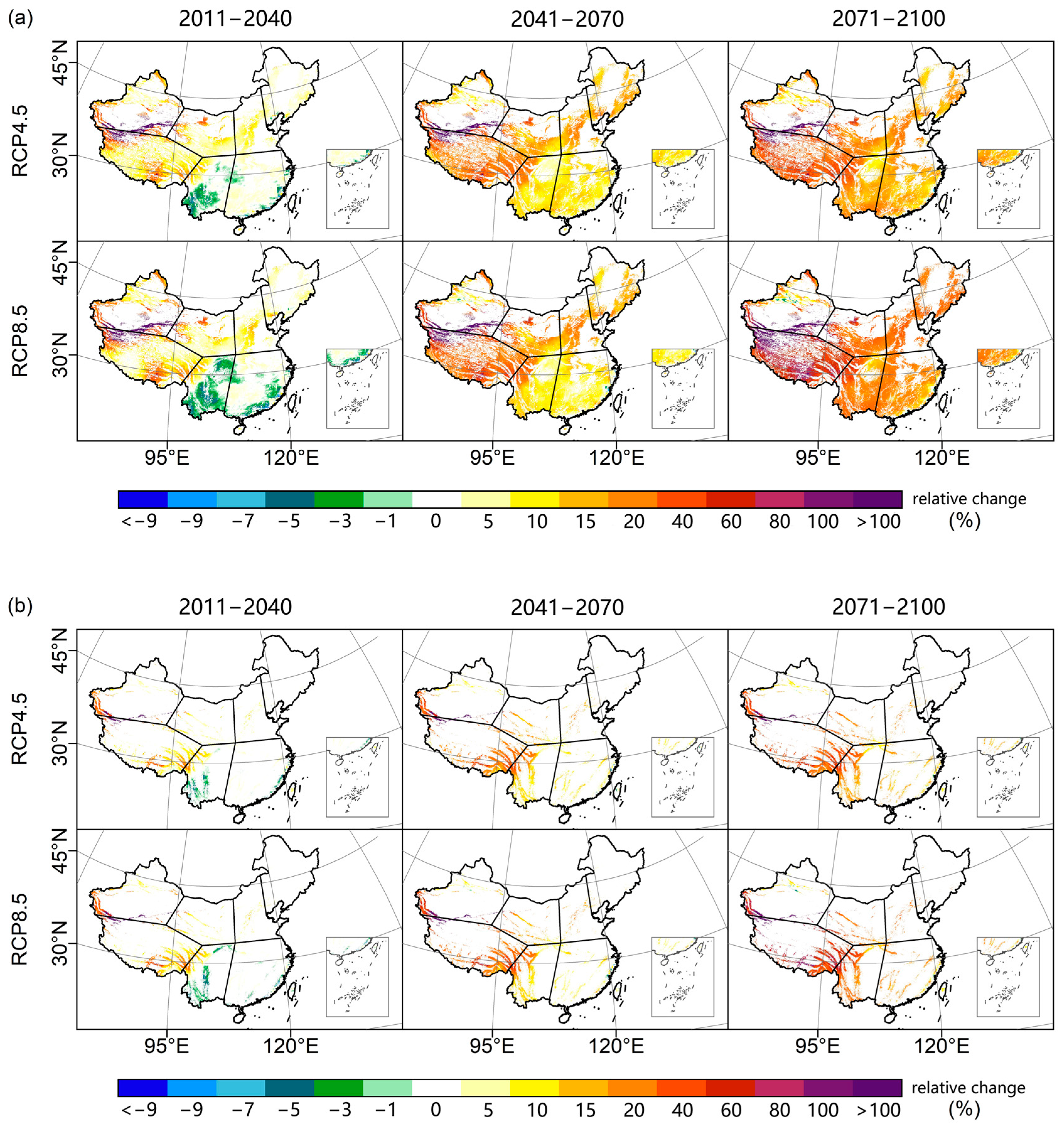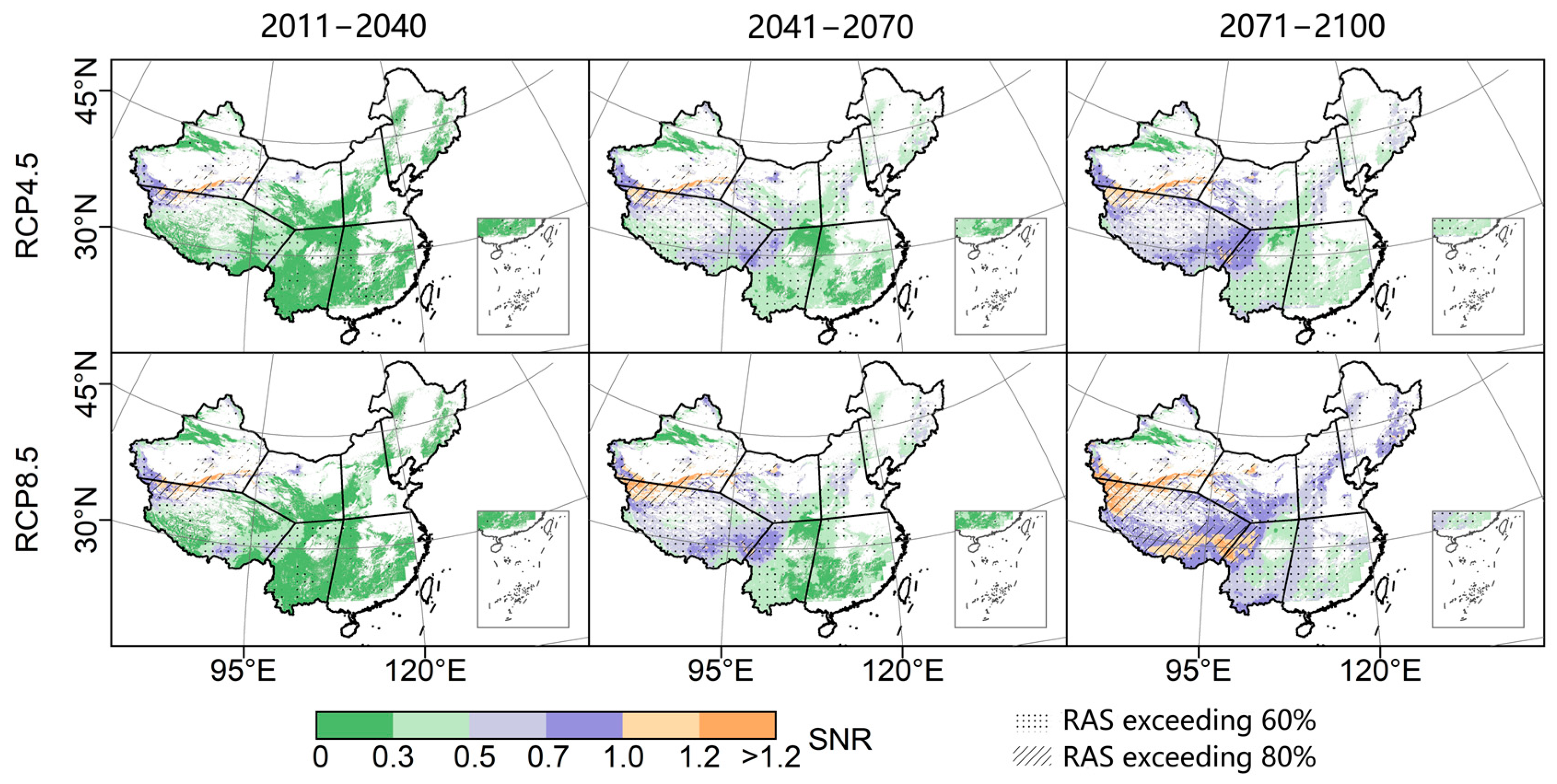Investigation of Model Uncertainty in Rainfall-Induced Landslide Prediction under Changing Climate Conditions
Abstract
:1. Introduction
2. Data and Methodology
2.1. Data Sources
2.2. Bias Correction and Spatial Disaggregation of GCMs
2.3. LHASA Model
2.4. Uncertainty Analysis Method
3. Results
3.1. GCM Rainfall Downscaling and Validation
3.2. Changes in Future Landslide Hazards in China
3.3. Uncertainty Analysis of Rainfall-Induced Landslide Prediction
4. Discussion
5. Conclusions
- (1)
- There is strong spatial and temporal heterogeneity in the variability of landslide hazard due to climate change. Compared with the historical period, the number of future landslide hazard basically shows an increasing trend, and the incidence of landslides under the RCP8.5 scenario is greater than that under the RCP4.5 scenario. In the early 21st century, there is expected to be a 5–10% increase in landslide hazards relative to the base period. The middle of the 21st century will see a more notable increase by 10–20%, with RCP8.5 having a slightly higher increase than RCP4.5, although not significantly. By the end of the 21st century, they will increase by 20–40% and 40–60% for RCP4.5 and RCP8.5, respectively. Spatially, the increase in the relative change in landslide hazards shows a spatial distribution characteristic of gradually increasing from east to west, corresponding to the topography of China. At the end of the 21st century, the relative increase in landslide hazard in the Tibetan Plateau, southwest, and southeast regions are 100%, 40%, and 20%, respectively. The seasonal differences in future landslide changes are significant, with the most increase in the spring and fall in most regions.
- (2)
- Overall, the GCM ensemble generally recognizes an upward trend in future landslide hazards in China, although the model has large uncertainties in the variability as well as the increase and decrease in changes. The SNR and the RAS are gradually increasing over time, and the consistency of the magnitude and positive and negative directions of the disaster changes predicted by the GCM are gradually strengthening. However, the uncertainty introduced by the RCP scenario is also rising. For each subregion, both the SNR and the RAS show high values in the west and lower values in the east. Except for parts of the Tibetan Plateau, where the SNR is greater than 1 and the RAS is more than 80%, uncertain levels are high in the remaining regions.
- (3)
- The characteristics of the distribution of uncertainty in the landslide prognoses are similar to those of the distribution of future variability in the landslide prognoses. In regions where the predicted future variability is small (<10%), both the SNR and RAS are low, resulting in high levels of uncertainty. Conversely, in locations where the variability is large (>60%), both the SNR and RAS are high, leading to reduced levels of uncertainty. Scenarios with high carbon emission concentrations will likely experience a greater degree of GCM ensemble for future extreme precipitation frequency compared to moderate and low carbon emission concentration scenarios, and will have stronger agreement and lower uncertainty in the variability, as well as incremental and decremental changes in landslide hazards.
Author Contributions
Funding
Data Availability Statement
Conflicts of Interest
References
- Maraun, D.; Knevels, R.; Mishra, A.N.; Truhetz, H.; Bevacqua, E.; Proske, H.; Zappa, G.; Brenning, A.; Petschko, H.; Schaffer, A.; et al. A severe landslide event in the Alpine foreland under possible future climate and land-use changes. Commun. Earth Environ. 2022, 3, 87. [Google Scholar] [CrossRef]
- Araújo, J.R.; Ramos, A.M.; Soares, P.M.M.; Melo, R.; Oliveira, S.C.; Trigo, R.M. Impact of extreme rainfall events on landslide activity in Portugal under climate change scenarios. Landslides 2022, 19, 2279–2293. [Google Scholar] [CrossRef]
- Pei, Y.; Qiu, H.; Zhu, Y.; Wang, J.; Yang, D.; Tang, B.; Wang, F.; Cao, M. Elevation dependence of landslide activity induced by climate change in the eastern Pamirs. Landslides 2023, 20, 1115–1133. [Google Scholar] [CrossRef]
- Thom, B.; Roberto, G. Invited perspectives: Hydrological perspectives on precipitation intensity-duration thresholds for landslide initiation: Proposing hydro-meteorological thresholds. Nat. Hazards Earth Syst. Sci. 2018, 18, 31–39. [Google Scholar]
- Valenzuela, P.; Zêzere, J.L.; Domínguez-Cuesta, M.J.; García, M.A.M. Empirical rainfall thresholds for the triggering of landslides in Asturias (NW Spain). Landslides 2019, 16, 1285–1300. [Google Scholar] [CrossRef]
- Liu, H.Z.; Xu, H.; Bao, H.J.; Xu, W.; Yan, X.F.; Xu, C.P. Characteristics analysis of rainfall-induced landslide thresholds in local regions. J. Nat. Disasters 2021, 30, 181–190. (In Chinese) [Google Scholar] [CrossRef]
- Giorgi, F.; Raffaele, F.; Coppola, E. The response of precipitation characteristics to global warming from climate projections. Earth Syst. Dyn. 2019, 10, 73–89. [Google Scholar] [CrossRef]
- O’gorman, P.A. Precipitation Extremes Under Climate Change. Curr. Clim. Chang. Rep. 2015, 1, 49–59. [Google Scholar] [CrossRef]
- Donat, M.G.; Lowry, A.L.; Alexander, L.V.; O’Gorman, P.A.; Maher, N. Addendum: More extreme precipitation in the world’s dry and wet regions. Nat. Clim. Chang. 2016, 6, 508–513. [Google Scholar] [CrossRef]
- O’gorman, P.A.; Schneider, T. Scaling of Precipitation Extremes over a Wide Range of Climates Simulated with an Idealized GCM. J. Clim. 2009, 22, 5676–5685. [Google Scholar] [CrossRef]
- Zhang, W.; Zhou, T. Increasing impacts from extreme precipitation on population over China with global warming. Sci. Bull. 2020, 65, 243–252. [Google Scholar] [CrossRef] [PubMed]
- Crozier, M.J. Deciphering the effect of climate change on landslide activity: A review. Geomorphology 2010, 124, 260–267. [Google Scholar] [CrossRef]
- Gao, Y.; Li, B.; Feng, Z.; Zuo, X. Global climate change and geological disaster response analysis. J. Geomech. 2017, 23, 65–77. (In Chinese) [Google Scholar]
- Gariano, S.L.; Fausto, G. Landslides in a changing climate. Earth-Sci. Rev. 2016, 162, 227–252. [Google Scholar] [CrossRef]
- Chen, C.-W.; Tung, Y.-S.; Liou, J.-J.; Li, H.-C.; Cheng, C.-T.; Chen, Y.-M.; Oguchi, T. Assessing landslide characteristics in a changing climate in northern Taiwan. Catena 2019, 175, 263–277. [Google Scholar] [CrossRef]
- Lee, M.J.; Song, W.K.; Won, J.S.; Park, I.; Lee, S. Spatial and temporal change in landslide hazard by future climate change scenarios using probabilistic-based frequency ratio model. Geocarto Int. 2014, 29, 639–662. [Google Scholar]
- Sobie, S.R. Future changes in precipitation-caused landslide frequency in British Columbia. Clim. Chang. 2020, 162, 465–484. [Google Scholar] [CrossRef]
- Janizadeh, S.; Bateni, S.M.; Jun, C.; Pal, S.C.; Band, S.S.; Chowdhuri, I.; Saha, A.; Tiefenbacher, J.P.; Mosavi, A. Potential impacts of future climate on the spatio-temporal variability of landslide susceptibility in Iran using machine learning algorithms and CMIP6 climate-change scenarios. Gondwana Res. 2023, 124, 1–17. [Google Scholar] [CrossRef]
- Yin, H.; Zhang, J.; Mondal, S.K.; Wang, B.; Zhou, L.; Wang, L.; Lin, Q. Projected Rainfall Triggered Landslide Susceptibility Changes in the Hengduan Mountain Region, Southwest China under 1.5–4.0 °C Warming Scenarios Based on CMIP6 Models. Atmosphere 2023, 14, 214. [Google Scholar] [CrossRef]
- Alvioli, M.; Melillo, M.; Guzzetti, F.; Rossi, M.; Palazzi, E.; von Hardenberg, J.; Brunetti, M.T.; Peruccacci, S. Implications of climate change on landslide hazard in Central Italy. Sci. Total. Environ. 2018, 630, 1528–1543. [Google Scholar] [CrossRef]
- Lin, Q.; Steger, S.; Pittore, M.; Zhang, J.; Wang, L.; Jiang, T.; Wang, Y. Evaluation of potential changes in landslide susceptibility and landslide occurrence frequency in China under climate change. Sci. Total Environ. 2022, 850, 158049. [Google Scholar] [CrossRef] [PubMed]
- Deser, C.; Phillips, A.; Bourdette, V.; Teng, H. Uncertainty in climate change projections: The role of internal variability. Clim. Dyn. 2012, 38, 527–546. [Google Scholar] [CrossRef]
- Asseng, S.; Ewert, F.; Rosenzweig, C.; Jones, J.W.; Hatfield, J.L.; Ruane, A.C.; Boote, K.J.; Thorburn, P.J.; Rötter, R.P.; Cammarano, D.; et al. Uncertainty in simulating wheat yields under climate change. Nat. Clim. Chang. 2013, 3, 827–832. [Google Scholar] [CrossRef]
- Kim, H.G.; Lee, D.K.; Park, C.; Kil, S.; Son, Y.; Park, J.H. Evaluating landslide hazards using RCP 4.5 and 8.5 scenarios. Environ. Earth Sci. 2015, 73, 1385–1400. [Google Scholar] [CrossRef]
- Ciabatta, L.; Camici, S.; Brocca, L.; Ponziani, F.; Stelluti, M.; Berni, N.; Moramarco, T. Assessing the impact of climate-change scenarios on landslide occurrence in Umbria Region, Italy. J. Hydrol. 2016, 541, 285–295. [Google Scholar] [CrossRef]
- Stanley, T.; Kirschbaum, D.B. A heuristic approach to global landslide susceptibility mapping. Nat. Hazards 2017, 87, 145–164. [Google Scholar] [CrossRef]
- Kirschbaum, D.; Stanley, T.; Zhou, Y. Spatial and temporal analysis of a global landslide catalog. Geomorphology 2015, 249, 4–15. [Google Scholar] [CrossRef]
- Miao, C.; Su, L.; Sun, Q.; Duan, Q. A nonstationary bias-correction technique to remove bias in GCM simulations. J. Geophys. Res. Atmos. 2016, 121, 5718–5735. [Google Scholar] [CrossRef]
- Rosa, D.; Collins, W.D. A case study of subdaily simulated and observed continental convective precipitation: CMIP5 and multiscale global climate models comparison. Geophys. Res. Lett. 2013, 40, 5999–6003. [Google Scholar] [CrossRef]
- Jia, K.; Ruan, Y.; Yang, Y.; You, Z. Assessment of CMIP5 GCM Simulation Performance for Temperature Projection in the Tibetan Plateau. Earth Space Sci. 2019, 6, 2362–2378. [Google Scholar] [CrossRef]
- Lovino, M.A.; Müller, O.V.; Berbery, E.H.; Müller, G.V. Evaluation of CMIP5 retrospective simulations of temperature and precipitation in northeastern Argentina. Int. J. Clim. 2018, 38, e1158–e1175. [Google Scholar] [CrossRef]
- Cannon, A.J.; Sobie, S.R.; Murdock, T.Q. Bias Correction of GCM Precipitation by Quantile Mapping: How Well Do Methods Preserve Changes in Quantiles and Extremes? J. Clim. 2015, 28, 6938–6959. [Google Scholar] [CrossRef]
- Wood, A.W.; Maurer, E.P.; Kumar, A.; Lettenmaier, D. Long-range experimental hydrologic forecasting for the eastern United States. J. Geophys. Res. 2002, 107, 4429. [Google Scholar] [CrossRef]
- Xu, L.; Wang, A. Application of the Bias Correction and Spatial Downscaling Algorithm on the Temperature Extremes from CMIP5 Multimodel Ensembles in China. Earth Space Sci. 2019, 6, 2508–2524. [Google Scholar] [CrossRef]
- Kirschbaum, D.; Stanley, T. Satellite-based assessment of rainfall-triggered landslide hazard for situational awareness. Earths Future 2018, 6, 505–523. [Google Scholar] [CrossRef] [PubMed]
- Amatya, P.; Kirschbaum, D.; Stanley, T. Rainfall-induced landslide inventories for Lower Mekong based on Planet imagery and a semi-automatic mapping method. Geosci. Data J. 2022, 9, 315–327. [Google Scholar] [CrossRef]
- Emberson, R.; Kirschbaum, D.; Stanley, T. New global characterisation of landslide exposure. Nat. Hazards Earth Syst. Sci. 2020, 20, 3413–3424. [Google Scholar] [CrossRef]
- Han, Z.Y.; Gao, X.J.; Xu, Y. Mean and extreme precipitation projection over land area of East Asia based on multiple regional climate models. Chin. J. Geophys. 2021, 64, 1869–1884. (In Chinese) [Google Scholar]
- Gu, L.; Chen, J.; Xu, C.-Y.; Kim, J.-S.; Chen, H.; Xia, J.; Zhang, L. The contribution of internal climate variability to climate change impacts on droughts. Sci. Total. Environ. 2019, 684, 229–246. [Google Scholar] [CrossRef]
- Tebaldi, C.; Arblaster, J.M.; Knutti, R. Mapping model agreement on future climate projections. Geophys. Res. Lett. 2011, 38, L23701. [Google Scholar] [CrossRef]
- Wang, A.; Lettenmaier, D.P.; Sheffield, J. Soil Moisture Drought in China, 1950–2006. J. Clim. 2011, 24, 3257–3271. [Google Scholar] [CrossRef]
- Lin, Q.; Wang, Y.; Glade, T.; Zhang, J.; Zhang, Y. Assessing the spatiotemporal impact of climate change on event rainfall characteristics influencing landslide occurrences based on multiple GCM projections in China. Clim. Chang. 2020, 162, 761–779. [Google Scholar] [CrossRef]
- Wang, T.; Miao, J.-P.; Sun, J.-Q.; Fu, Y.-H. Intensified East Asian summer monsoon and associated precipitation mode shift under the 1.5 °C global warming target. Adv. Clim. Chang. Res. 2018, 9, 102–111. [Google Scholar] [CrossRef]
- Wu, Y.; Wu, S.-Y.; Wen, J.; Tagle, F.; Xu, M.; Tan, J. Future Changes in Mean and Extreme Monsoon Precipitation in the Middle and Lower Yangtze River Basin, China, in the CMIP5 Models. J. Hydrometeorol. 2016, 17, 2785–2797. [Google Scholar] [CrossRef]
- Kirschbaum, D.; Kapnick, S.B.; Stanley, T.; Pascale, S. Changes in Extreme Precipitation and Landslides Over High Mountain Asia. Geophys. Res. Lett. 2020, 47, e2019GL085347. [Google Scholar] [CrossRef]
- He, S.; Wang, J.; Wang, H. Projection of Landslides in China during the 21st Century under the RCP8.5 Scenario. J. Meteorol. Res. 2019, 33, 138–148. [Google Scholar] [CrossRef]
- Wu, C.; Yeh, P.J.-F.; Ju, J.; Chen, Y.-Y.; Xu, K.; Dai, H.; Niu, J.; Hu, B.X.; Huang, G. Assessing the Spatiotemporal Uncertainties in Future Meteorological Droughts from CMIP5 Models, Emission Scenarios, and Bias Corrections. J. Clim. 2021, 34, 1903–1922. [Google Scholar] [CrossRef]
- Gao, J.; Sheshukov, A.Y.; Yen, H.; Douglas-Mankin, K.R.; White, M.J.; Arnold, J.G. Uncertainty of hydrologic processes caused by bias-corrected CMIP5 climate change projections with alternative historical data sources. J. Hydrol. 2019, 568, 551–561. [Google Scholar] [CrossRef]
- Chen, Y.; Zhao, L.; Wang, Y.; Jiang, Q.; Qi, D. Precipitation data and their uncertainty as input for rainfall-induced shallow landslide models. Front. Earth Sci. 2019, 13, 695–704. [Google Scholar] [CrossRef]
- Homsi, R.; Shiru, M.S.; Shahid, S.; Ismail, T.; Bin Harun, S.; Al-Ansari, N.; Chau, K.-W.; Yaseen, Z.M. Precipitation projection using a CMIP5 GCM ensemble model: A regional investigation of Syria. Eng. Appl. Comput. Fluid Mech. 2020, 14, 90–106. [Google Scholar] [CrossRef]
- Stanley, T.A.; Kirschbaum, D.B.; Benz, G.; Emberson, R.A.; Amatya, P.M.; Medwedeff, W.; Clark, M.K. Data-Driven Landslide Nowcasting at the Global Scale. Front. Earth Sci. 2021, 9, 640043. [Google Scholar] [CrossRef]
- Zhuo, L.; Dai, Q.; Han, D.; Chen, N.; Zhao, B.; Berti, M. Evaluation of Remotely Sensed Soil Moisture for Landslide Hazard Assessment. IEEE J. Sel. Top. Appl. Earth Obs. Remote Sens. 2019, 12, 162–173. [Google Scholar] [CrossRef]
- Zhao, B.; Dai, Q.; Han, D.; Mao, J.; Zhuo, L.; Rong, G. Estimation of soil moisture using modified antecedent precipitation index with application in landslide predictions. Landslides 2019, 16, 2381–2393. [Google Scholar] [CrossRef]
- Zhao, B.; Dai, Q.; Han, D.; Dai, H.; Mao, J.; Zhuo, L. Probabilistic thresholds for landslides warning by integrating soil moisture conditions with rainfall thresholds. J. Hydrol. 2019, 574, 276–287. [Google Scholar] [CrossRef]
- Khan, S.; Kirschbaum, D.B.; Stanley, T.A.; Amatya, P.M.; Emberson, R.A. Global Landslide Forecasting System for Hazard Assessment and Situational Awareness. Front. Earth Sci. 2022, 10, 878996. [Google Scholar] [CrossRef]






| Paradigm | Country | Institution (Abbr.) | Resolution (Grid Points in Latitude × Longitude Directions) |
|---|---|---|---|
| ACCESS1-0 | Australia | CSIRO-BOM | 192 × 145 |
| ACCESS1-3 | Australia | CSIRO-BOM | 192 × 145 |
| CMCC-CM | Italy | CMCC | 480 × 240 |
| CMCC-CMS | Italy | CMCC | 192 × 96 |
| CNRM-CM5 | France | CNRM-CERFACS | 256 × 128 |
| FGOALS-g2 | China | LASG-CESS | 128 × 60 |
| GFDL-CM3 | USA | NOAA-GFDL | 144 × 90 |
| GFDL-ESM2G | USA | NOAA-GFDL | 144 × 90 |
| GFDL-ESM2M | USA | NOAA-GFDL | 144 × 90 |
| INM-CM4 | Russia | INM | 180 × 120 |
| IPSL-CM5A-MR | France | IPSL | 144 × 143 |
| MIROC5 | Japan | MIROC | 256 × 128 |
| MPI-ESM-LR | Germany | MPI-M | 192 × 96 |
| MPI-ESM-MR | Germany | MPI-M | 192 × 96 |
| MRI-CGCM3 | Japan | MRI | 320 × 160 |
| NorESM1-M | Norway | NCC | 144 × 96 |
| China | NEC | NC | SEC | ENWC | SWC | WNWC | TC | |||
|---|---|---|---|---|---|---|---|---|---|---|
| SNR | RCP4.5 | 2011–2100 | 0.44 | 0.43 | 0.40 | 0.37 | 0.47 | 0.36 | 0.62 | 0.53 |
| 2011–2040 | 0.33 | 0.29 | 0.28 | 0.31 | 0.32 | 0.24 | 0.56 | 0.35 | ||
| 2041–2070 | 0.46 | 0.50 | 0.44 | 0.36 | 0.50 | 0.38 | 0.62 | 0.57 | ||
| 2071–2100 | 0.54 | 0.51 | 0.52 | 0.44 | 0.63 | 0.50 | 0.68 | 0.71 | ||
| RCP8.5 | 2011–2100 | 0.50 | 0.51 | 0.47 | 0.38 | 0.57 | 0.42 | 0.70 | 0.65 | |
| 2011–2040 | 0.35 | 0.27 | 0.28 | 0.27 | 0.36 | 0.26 | 0.63 | 0.39 | ||
| 2041–2070 | 0.49 | 0.50 | 0.49 | 0.35 | 0.57 | 0.40 | 0.70 | 0.67 | ||
| 2071–2100 | 0.69 | 0.81 | 0.68 | 0.54 | 0.80 | 0.63 | 0.78 | 0.94 | ||
| RAS (%) | RCP4.5 | 2011–2100 | 59.11 | 51.66 | 59.06 | 50.97 | 63.93 | 61.38 | 69.09 | 66.62 |
| 2011–2040 | 56.75 | 49.00 | 55.52 | 50.76 | 59.14 | 58.50 | 67.36 | 60.22 | ||
| 2041–2070 | 59.10 | 52.89 | 59.76 | 49.83 | 64.42 | 61.09 | 69.18 | 67.62 | ||
| 2071–2100 | 61.86 | 53.53 | 62.48 | 52.35 | 69.03 | 65.02 | 71.02 | 73.09 | ||
| RCP8.5 | 2011–2100 | 61.15 | 53.87 | 61.54 | 51.85 | 67.27 | 63.17 | 71.56 | 71.38 | |
| 2011–2040 | 57.17 | 48.20 | 55.40 | 49.87 | 60.40 | 59.53 | 69.35 | 62.13 | ||
| 2041–2070 | 60.55 | 52.99 | 62.39 | 50.28 | 67.48 | 62.03 | 71.64 | 71.39 | ||
| 2071–2100 | 66.40 | 61.35 | 67.86 | 55.73 | 75.06 | 68.57 | 74.07 | 82.15 |
Disclaimer/Publisher’s Note: The statements, opinions and data contained in all publications are solely those of the individual author(s) and contributor(s) and not of MDPI and/or the editor(s). MDPI and/or the editor(s) disclaim responsibility for any injury to people or property resulting from any ideas, methods, instructions or products referred to in the content. |
© 2023 by the authors. Licensee MDPI, Basel, Switzerland. This article is an open access article distributed under the terms and conditions of the Creative Commons Attribution (CC BY) license (https://creativecommons.org/licenses/by/4.0/).
Share and Cite
Chen, Y.; Chen, E.; Zhang, J.; Zhu, J.; Xiao, Y.; Dai, Q. Investigation of Model Uncertainty in Rainfall-Induced Landslide Prediction under Changing Climate Conditions. Land 2023, 12, 1732. https://doi.org/10.3390/land12091732
Chen Y, Chen E, Zhang J, Zhu J, Xiao Y, Dai Q. Investigation of Model Uncertainty in Rainfall-Induced Landslide Prediction under Changing Climate Conditions. Land. 2023; 12(9):1732. https://doi.org/10.3390/land12091732
Chicago/Turabian StyleChen, Yulin, Enze Chen, Jun Zhang, Jingxuan Zhu, Yuanyuan Xiao, and Qiang Dai. 2023. "Investigation of Model Uncertainty in Rainfall-Induced Landslide Prediction under Changing Climate Conditions" Land 12, no. 9: 1732. https://doi.org/10.3390/land12091732





